Dimethylamine (DMA) in Tetrahydrofuran (THF):
Dimethylamine (DMA) in Tetrahydrofuran (THF) is a solution consisting of gaseous dimethylamine dissolved in tetrahydrofuran, a commonly used organic solvent. This solution is widely used in organic synthesis as a nucleophile, base, and reagent for amination reactions. The combination of DMA and THF offers a non-aqueous medium that is ideal for various industrial and laboratory chemical processes, particularly in base-catalyzed reactions and the preparation of amines.
Formula:
(CH₃)₂NH in C₄H₈O
Synonyms of Dimethylamine (DMA) in Tetrahydrofuran (THF):
- DMA in THF
- Dimethylamine-Tetrahydrofuran Solution
- Dimethylamine in THF
- (CH₃)₂NH/THF Solution
Characteristics of Dimethylamine (DMA) in Tetrahydrofuran (THF):
- Physical State: Colorless, volatile liquid with a strong, ammonia-like odor.
- Solubility: Fully soluble in THF and other organic solvents, providing a stable, non-aqueous environment.
- Reactivity: Acts as a strong nucleophile and base, widely used in amination, methylation, and nucleophilic substitution reactions.
- Basicity: Provides a highly basic solution, ideal for deprotonation and base-catalyzed reactions.
Applications of Dimethylamine (DMA) in Tetrahydrofuran (THF):
Used to introduce dimethylamine groups into organic molecules, crucial for producing secondary amines.
Serves as a methylating agent in organic synthesis.
Used in the production of active pharmaceutical ingredients (APIs) and drug intermediates.
Utilized in the creation of resins and polymers via base-catalyzed processes.
Benefits of Dimethylamine (DMA) in Tetrahydrofuran (THF):
- Strong Nucleophile: Efficiently donates lone pairs of electrons, enabling rapid nucleophilic reactions.
- Versatile Solvent: THF offers excellent solubility and stability for DMA, enhancing its reactivity in organic processes.
- Non-Aqueous Medium: THF provides a non-aqueous environment, reducing the risk of side reactions caused by water.
- Efficient Methylating Agent: DMA acts as an effective methyl donor in various chemical reactions.
What are the Safety Considerations for 5-Bromo-2-Chlorobenzoic Acid


While generally regarded as safe for its intended uses, appropriate precautions should be taken when handling 5-bromo-2-chlorobenzoic acid:
Ensure proper ventilation to avoid inhalation of vapors.
Store in a cool, well-ventilated area away from heat sources and incompatible substances.
Use gloves, goggles, and protective clothing to prevent skin and eye contact.
Avoid exposure to moisture, as DMA is highly reactive, and THF is highly flammable. Handle with care due to the volatile and corrosive nature of the solution.
Dimethylamine in Tetrahydrofuran is a highly reactive solution that serves as a valuable tool in organic synthesis, particularly in amination and methylation reactions. Its strong nucleophilicity and compatibility with non-aqueous environments make it an essential reagent in both industrial and laboratory applications, provided proper safety precautions are followed.
We Provide Best in class service and on time delivery to fulfill the requirement of this product worldwide.

